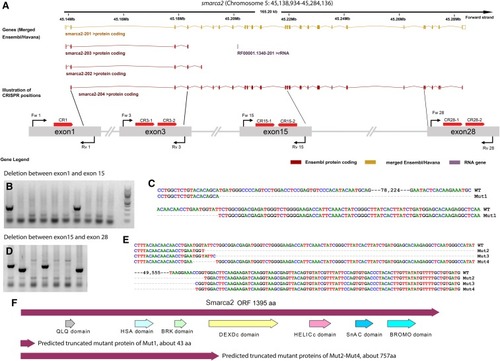
Multiple gRNAs targeting smarca2 exons induced LKO deletions in zebrafish. (A) Schematic diagram of gRNAs’ targeting smarca2 exons based on Ensembl annotation. Red bars with arrows indicate the positions of gRNAs against the smarca2 coding DNA. Red arrows match the gRNA directions. The lengths of illustrated exons are not proportional to the real size of corresponding exons. Black lines and arrows represent primers and their directions. The exon number is based on the longest transcript, smarca2-204. Note: Some of the exons may look like one exon on the graph due to their small size and close proximity. (B) Representatives of positive adult F1 fish by PCR with primers Fw 1 and Rv 15. No PCR products in wildtype due to the large size of amplicon. PCR works if there is a deletion between exon 1 and exon 15. Each lane is corresponding to an F1 adult fish. (C) Large deletion (78,288bp) between exon 1 and exon15 was confirmed by Sanger sequencing. 78,224bp is the size of the omitted region including the dashes. (D) Representatives of positive mutants identified by PCR between exon 15 and 28 with primers Fw 15 and Rv 28. Three different sized PCR bands were identified. Each lane is corresponding to an F1 adult fish. (E) Three large deletions (Mut2-Mut4) between exon 15 and exon 28 from different fish were confirmed by Sanger sequencing. Each line represents a type of mutation. 49,555bp is the size of the omitted region including the dashes. (F) Predicted zebrafish Smarca2 wildtype and mutant proteins based on the mutation positions. Protein domains were based on cBioPortal and SMART annotations. Only wildtype protein from the longest transcript (smarca2-204) is shown here. Mutant protein sizes were calculated by the ORF finder.
|

